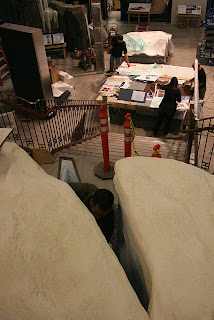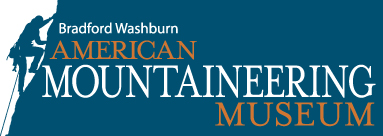
The famed Schoening Ice Axe. Courtesy of the Washington State Historical Society

Fred Poyner, of the Washington State Historical Society, inspects the axe after removing it from the shipping crate.

Next, Museum Director Niña Johnson has a look.

The installation team from Quatrefoil positions the axe within its secure case, as the director looks on.

The position is marked and the axe is ready to be installed.
On December 5, 2007, the Bradford Washburn American Mountaineering Museum took delivery of one of the most historic artifacts in the world of mountaineering – the Schoening ice axe. The axe was used to save the lives of five men, and has come to represent the pinnacle of mountaineering ethics. The axe will be on loan from the Washington State Historical Society.
The year 1953 was a great one for mountaineering. By its end, the summit of Mt. Everest was achieved after so many previous failures. Austrian Hermann Buhl climbed alone to the summit of Nanga Parbat in Pakistan to become the first person ever to complete a solo first ascent of an 8000 meter peak. On K2, the world’s second highest mountain, however, a saga unfolded that has forever remained etched in the annals of mountaineering. It was not to be a successful expedition—the summit would remain unclimbed until the following year. But the tenacity and strength displayed by the members of the expedition team remain legendary.
A storm on the Abruzzi Ridge—25,000 feet up on the slopes of K2—sent climbers led by Charles Houston, a doctor from Seattle, scrambling to save the life of a fellow mountaineer. Climbing alpine style without the aid of oxygen, team member Art Gilkey’s legs were filling with blood clots. With no other option than to get Gilkey to a lower elevation as fast as possible, the team began to maneuver him down the precariously steep and icy slope in the middle of a vicious storm, in his sleeping bag. That is until George Bell lost his footing and, in the ensuing entanglement of ropes and climbers, five men started plunging towards their deaths off the face of the mountain.
The youngest and strongest man on this expedition team, however, would keep this expedition from being remembered solely for its tragedies. Moments after Gilkey, still in his sleeping bag, and the other five men began sliding to their deaths, a chemist from Seattle, Pete Schoening, instinctually jammed his ice axe behind a boulder— an impromptu rope belay, with the rope wrapped around his hip and the wooden shaft of the axe—and instantaneously arrested five men from hurtling to their deaths.
Unfortunately, Gilkey would later be swept into the void by an avalanche. Still, Schoening’s simple yet life-altering act has since defined the expedition: “The Belay” is now recognized as one of the most heroic acts in all of mountaineering history.
The Bradford Washburn American Mountaineering Museum is now the home of this iconic piece of equipment and the story of Pete Schoening and his exemplary behavior in the thin air of the Karakoram Range.
The five lives that dangled from Schoening’s ice axe so far away in Pakistan have since blossomed into what has been described, by the daughter of a dangling expedition member, as “Children of the Belay.” Karen Molenaar Terrell, daughter of team member Dee Molenaar, was able to bring the children, grandchildren, and other relatives of those dangling souls together for a reunion—the photograph tells you there are more than 30 people alive today because of “The Belay”—because of Pete Schoening.
Schoening was not just a heroic mountaineer, however. He was a pioneering one as well. He led the first ascents of Mount Augusta and the East Ridge of King Peak in the Yukon in 1952. Along with Andy Kaufmann, he summited Gasherbrum I (Hidden Peak) in 1958, thus completing the only American first ascent of an 8,000-meter peak. In 1966, he made the first ascent of Antarctica’s highest summit, Vinson Massif.
But it was that day in August of 1953 that has become the classic mountaineering tale and a symbol for many of alpine ethics at its best: friendship between climbing partners had prevailed above all other considerations. As was later recounted in the book K2: The Savage Mountain, it was upon the cold, precipitous slopes of one of the world's wildest mountains, with hypoxia-challenged minds their only aid for survival, that these mountaineers felt as though they had reached "the core of life itself."























































